<Back to Index>
- Astronomer, Physicist and Mathematician Edmond Halley, 1656
- Astronomer and Composer Friedrich Wilhelm Herschel, 1738
PAGE SPONSOR
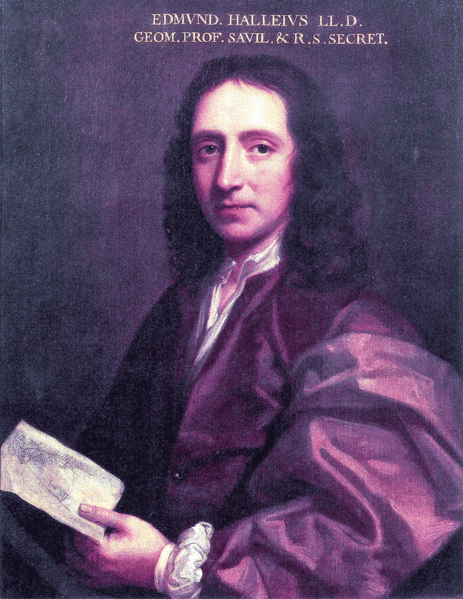
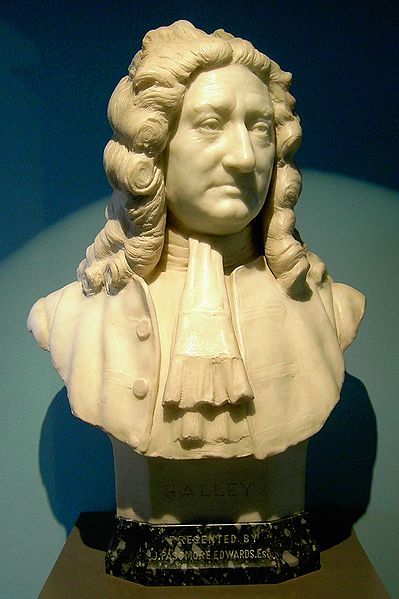
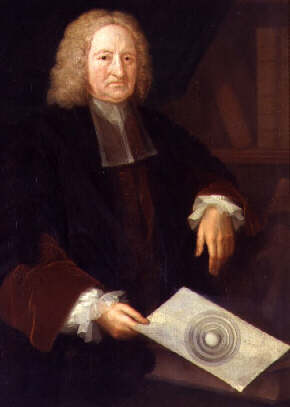
Edmond Halley FRS (8 November 1656 – 14 January 1742) was an English astronomer, geophysicist, mathematician, meteorologist, and physicist who is best known for computing the orbit of the eponymous Halley's Comet. He was the second Astronomer Royal in Britain, following in the footsteps of John Flamsteed.
Halley was born in Haggerston, Shoreditch, England. His father, Edmond Halley Sr., came from a Derbyshire family and was a wealthy soap maker in London. As a child, Halley was very interested in mathematics. He studied at St Paul's School, and then, from 1673, at The Queen's College, Oxford. While an undergraduate, Halley published papers on the Solar System and sunspots.
On leaving Oxford, in 1676, Halley visited the south Atlantic island of Saint Helena and set up an observatory with a 24 foot long (7.3 m) aerial telescope with the intention of studying stars from the Southern Hemisphere. He returned to England in November 1678. In the following year he went to Danzig (Gdańsk) on behalf of the Royal Society to help resolve a dispute. Because astronomer Johannes Hevelius did not use a telescope, his observations had been questioned by Robert Hooke. Halley stayed with Hevelius and he observed and verified the quality of Hevelius' observations. The same year Halley published Catalogus Stellarum Australium which included details of 341 southern stars. These additions to present day star maps earned him comparison with Tycho Brahe. Halley was awarded his M.A. degree at Oxford and elected as a Fellow of the Royal Society.
In 1686 Halley published the second part of the results from his Helenian expedition, being a paper and chart on trade winds and monsoons. In this he identified solar heating as the cause of atmospheric motions. He also established the relationship between barometric pressure and height above sea level. His charts were an important contribution to the emerging field of information visualization.
Halley married Mary Tooke in 1682 and settled in Islington. The couple had three children. He spent most of his time on lunar observations, but was also interested in the problems of gravity. One problem that attracted his attention was the proof of Kepler's laws of planetary motion. In August 1684 he went to Cambridge to discuss this with Sir Isaac Newton, only to find that Newton had solved the problem, but published nothing. Halley convinced him to write the Philosophiæ Naturalis Principia Mathematica (1687), which was published at Halley's expense.
In 1691, Halley built a diving bell, a device in which the atmosphere was replenished by way of weighted barrels of air sent down from the surface. In a demonstration, Halley and five companions dived to 60 feet in the River Thames, and remained there for over an hour and a half. Halley's bell was of little use for practical salvage work, as it was very heavy, but he made improvements to it over time, later extending his underwater exposure time to over 4 hours. Halley suffered one of the earliest recorded cases of middle ear barotrauma. That same year, at a meeting of the Royal Society, Halley introduced a rudimentary working model of a magnetic compass using a liquid filled housing to damp the swing and wobble of the magnetized needle.
In 1691 Halley sought the post of Savilian Professor of Astronomy at Oxford, but, due to his well known atheism, was opposed by the Archbishop of Canterbury, John Tillotson and Bishop Stillingfleet. The post went instead to David Gregory, who had the support of Isaac Newton.
In 1692, Halley put forth the idea of a hollow Earth consisting of a shell about 500 miles (800 km) thick, two inner concentric shells and an innermost core, about the diameters of the planets Venus, Mars, and Mercury. He suggested that atmospheres separated these shells, and that each shell had its own magnetic poles, with each sphere rotating at a different speed. Halley proposed this scheme in order to explain anomalous compass readings. He envisaged each inner region as having an atmosphere and being luminous (and possibly inhabited), and speculated that escaping gas caused the Aurora Borealis.
In 1693 Halley published an article on life annuities, which featured an analysis of age - at - death on the basis of the Breslau statistics Caspar Neumann had been able to provide. This article allowed the British government to sell life annuities at an appropriate price based on the age of the purchaser. Halley's work strongly influenced the development of actuarial science. The construction of the life - table for Breslau, which followed more primitive work by John Graunt, is now seen as a major event in the history of demography.
In 1698, Halley was given the command of the Paramour, a 52 foot pink, so that he could carry out investigations in the South Atlantic into the laws governing the variation of the compass.
On 19 August 1698, he took command of the ship and, in November 1698,
sailed on what was the first purely scientific voyage by an English
naval vessel. Unfortunately problems of insubordination arose
over questions of Halley's competence to command a vessel. Halley
returned the ship to England to proceed against his officers in July
1699. The result was a mild rebuke for his men, and dissatisfaction for
Halley, who felt the court had been too lenient. Halley thereafter received a temporary commission as a Captain in the Royal Navy, recommissioned the Paramour on 24 August 1699 and sailed again in September 1699 to make extensive observations on the conditions of terrestrial magnetism.
This task he accomplished in a second Atlantic voyage which lasted
until 6 September 1700, and extended from 52 degrees north to 52 degrees
south. The results were published in General Chart of the Variation of the Compass (1701). This was the first such chart to be published and the first on which isogonic, or Halleyan, lines appeared.
The preface to Awnsham and John Churchill’s collection of Voyage and travels (1704), perhaps by John Locke or by Edmond Halley, made the link.
“Natural and moral history is embellished with the most beneficial increase of so many thousands of plants it had never before received, so many drugs and spices, such unaccountable diversity. Trade is raised to highest pitch, and this not in a niggard and scanty manner as when the Venetians served all Europe ... the empire of Europe is now extended to the utmost bounds of the Earth.”
In November 1703 Halley was appointed Savilian Professor of Geometry at the University of Oxford, his theological enemies, John Tillotson and Bishop Stillingfleet having died, and received an honorary degree of doctor of laws in 1710. In 1705, applying historical astronomy methods, he published Synopsis Astronomia Cometicae,
which stated his belief that the comet sightings of 1456, 1531, 1607,
and 1682 related to the same comet, which he predicted would return in
1758. Halley did not live to witness the comet's return, but when it
did, the comet became generally known as Halley's Comet.
In 1716 Halley suggested a high precision measurement of the distance between the Earth and the Sun by timing the transit of Venus. In doing so he was following the method described by James Gregory in Optica Promota (in which the design of the Gregorian telescope is also described). It is reasonable to assume Halley possessed and had read this book given that the Gregorian design was the principal telescope design used in astronomy in Halley's day. It is not to Halley's credit that he failed to acknowledge Gregory's priority in this matter. In 1718 he discovered the proper motion of the "fixed" stars by comparing his astrometric measurements with those given in Ptolemy's Almagest. Arcturus and Sirius were two noted to have moved significantly, the latter having progressed 30 arc minutes (about the diameter of the moon) southwards in 1800 years.
In 1720, together with his friend the antiquarian William Stukeley, Halley participated in the first attempt to scientifically date Stonehenge. Assuming that the monument had been laid out using a magnetic compass, Stukeley and Halley attempted to calculate the perceived deviation introducing corrections from existing magnetic records, and suggested three dates (AD 920, AD 220 and 460 BC), the earliest being the one accepted. These dates were wrong by thousands of years, but the idea that scientific methods could be used to date ancient monuments was revolutionary in its day.
Halley succeeded John Flamsteed in 1720 as Astronomer Royal, a position Halley held until his death in 1742 at the age of 85. Halley was buried in the graveyard of the old church of St. Margaret, (now ruined) at Lee, South London . In the same vault is Astronomer Royal John Pond; the unmarked grave of Astronomer Royal Nathaniel Bliss is nearby.
There are three pronunciations of the surname Halley. The most common, both in Great Britain and in the United States, is /ˈhæli/, rhyming with valley. This is the personal pronunciation used by most Halleys living in London today. The alternative /ˈheɪli/, rhyming with daily, is often preferred for the man and the comet by those who grew up with rock and roll singer Bill Haley, who called his backing band his "Comets" after the common pronunciation of Halley's Comet in the United States at the time. Colin Ronan, one of Halley's biographers, preferred /ˈhɔːli/, as in hall or haul. Contemporary accounts spell his name Hailey, Hayley, Haley, Haly, Halley, Hawley and Hawly, and presumably pronunciations varied similarly.
As for his given name, although the spelling "Edmund" is quite common, "Edmond" is what Halley himself used.
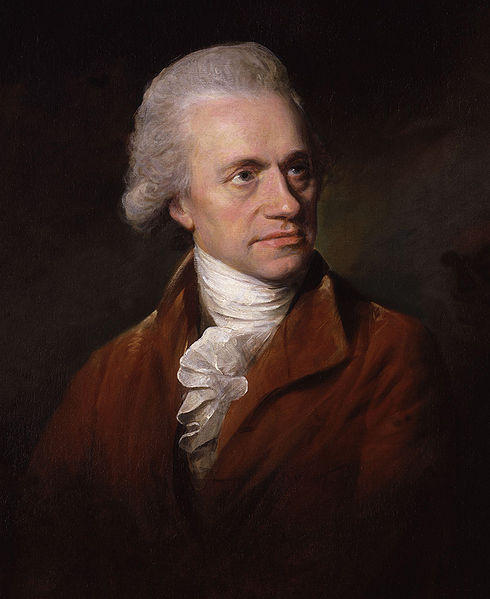
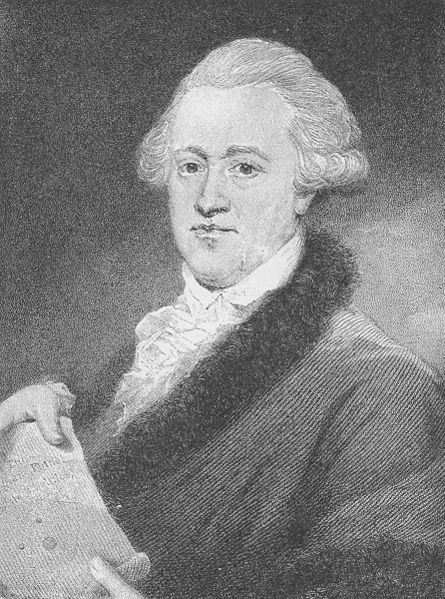
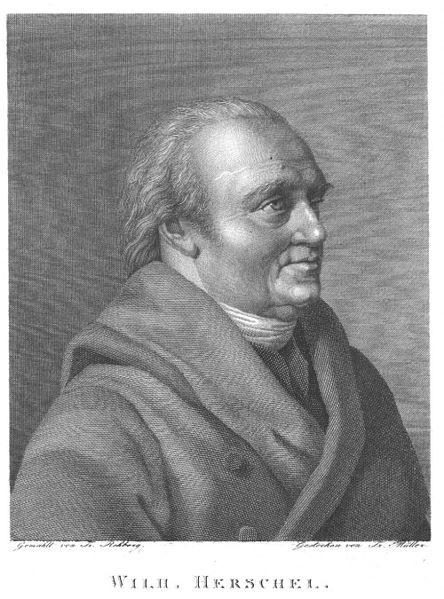
Sir Frederick William Herschel, KH, FRS, German: Friedrich Wilhelm Herschel (15 November 1738 – 25 August 1822) was a German born British astronomer, technical expert, and composer. Born in Hanover, Wilhelm first followed his father into the Military Band of Hanover, but emigrated to Britain at age 19. Herschel became most famous for the discovery of Uranus in addition to two of its major moons, Titania and Oberon. He also discovered two moons of Saturn and infrared radiation. Herschel is also known for the twenty - four symphonies that he composed.
Sir William Herschel lived most of his life in Slough and is a man very much respected in the Berkshire town. He died in Slough and was also buried there. A new Bus Station was built in the center of Slough in 2011 and the design was inspired by the infrared experiment of Sir William Herschel. He was buried under the tower of St Laurence's Church, Upton, Slough. The Shopping center in the town, 'The Observatory', also comes in memory of him.
Herschel was born in Hanover, Electorate of Hanover, one of ten children of Isaak and Anna Ilse, née Moritzen, Herschel. His father was of Jewish descent and an oboist in the Hannover Military Band. In 1755 the Hannoverian Guards regiment, in whose band Wilhelm and his brother Jakob were engaged as oboists, was ordered to England. At the time the crowns of Great Britain and Hannover were united under George II. As the threat of war with France loomed, the Hannoverian Guard was recalled from England to defend Hannover. After the Hannoverian guard was defeated at the Battle of Hastenbeck, Herschel's father Isaak sent his two sons to seek refuge in England in late 1757. Although his older brother Jakob had received his dismissal from the Hannoverian Guard, Wilhelm was accused of desertion (for which he was pardoned by George III in 1782). Wilhelm, nineteen years old at this time, was a quick student of the English language. In England he went by the English rendition of his name, Frederick William Herschel.
He played the cello and harpsichord in addition to the oboe and later the organ. He composed numerous musical works, including 24 symphonies and many concertos, as well as some church music. Six of his symphonies are available in excellent recordings made in 2003 by the London Mozart Players, conducted by Matthias Bamert.
Herschel moved to Sunderland in 1761 when Charles Avison immediately engaged him as first violin and soloist for his Newcastle orchestra, where he played for one season. In ‘Sunderland in the County of Durham 20 April 1761’ he wrote his symphony no. 8 in C minor. He was head of the Durham Militia band 1760 – 61 and visited the home of Sir Ralph Milbanke at Halnaby Hall in 1760, where he wrote two symphonies, as well as giving performances himself.
After Newcastle he moved to Leeds and Halifax where he was the first organist at St John the Baptist church. He became organist of the Octagon Chapel, Bath, a fashionable chapel in a well known spa, in which town he was also Director of Public Concerts. He was appointed as the organist in 1766 and gave his introductory concert on 1 January 1767. As the organ was still incomplete he showed off his versatility by performing his own compositions including a violin concerto, an oboe concerto and a harpsichord sonata. The organ was completed in October 1767. His sister Caroline came to England in 1772 and lived with him there in New King Street. His brothers Dietrich, Alexander and Jakob (1734 – 1792) also appeared as musicians of Bath. In 1780, Herschel was appointed director of the Bath orchestra, with his sister often appearing as soprano soloist.
Herschel's music led him to an interest in mathematics and lenses. His interest in astronomy grew stronger after he made the acquaintance of the English Astronomer Royal Nevil Maskelyne. He started building his own reflecting telescopes and would spend up to 16 hours a day grinding and polishing the speculum metal primary mirrors. He "began to look at the planets and the stars" in May, 1773 and on 1 March 1774 began an astronomical journal by noting his observations of Saturn's rings and the Great Orion Nebula (M 42).
Herschel's early observational work soon focused on the search for visually very close pairs of stars. Astronomers of the era expected that changes over time in the apparent separation and relative location of these stars would provide evidence both for the proper motion of stars and, by means of parallax shifts in their separation, for the distance of stars from the Earth (a method first suggested by Galileo Galilei). From the back garden of his house in New King Street, Bath, and using a 6.2 inch aperture (160 mm), 7 foot focal length (2.1 m) (f/13) Newtonian telescope "with a most capital speculum" of his own manufacture, Herschel began a systematic search for these stars among "every star in the Heavens" in October, 1779 and continued listing discoveries through 1792. He soon discovered many more binary and multiple stars than expected, and compiled them with careful measurements of their relative positions in two catalogs presented to the Royal Society, London, in 1782 (269 double or multiple systems) and 1784 (434 systems). A third catalog of discoveries made after 1783 was published in 1821 (145 systems). In 1797 Herschel measured many of the systems again, and discovered changes in their relative positions that could not be attributed to the parallax caused by the Earth's orbit. He waited until 1802 (in Catalogue of 500 new Nebulae, nebulous Stars, planetary Nebulae, and Clusters of Stars; with Remarks on the Construction of the Heavens) to announce the hypothesis that the two stars might be "binary sidereal systems" orbiting under mutual gravitational attraction, a hypothesis he confirmed in 1803 in his Account of the Changes that have happened, during the last Twenty - five Years, in the relative Situation of Double - stars; with an Investigation of the Cause to which they are owing. In all, Herschel discovered over 800 confirmed double or multiple star systems, almost all of them physical rather than virtual pairs. His theoretical and observational work provided the foundation for modern binary star astronomy; new catalogs adding to his work were not published until after 1820 by Friedrich Wilhelm Struve, James South and John Herschel.
In March, 1781, during his search for double stars, Herschel noticed an object appearing as a nonstellar disk. Herschel originally thought it was a comet or a star. He made many more observations of it, and afterwards Russian Academician Anders Lexell computed the orbit and found it to be probably planetary. Herschel determined in agreement that it must be a planet beyond the orbit of Saturn. He called the new planet the 'Georgian star' (Georgium sidus) after King George III, which also brought him favor; the name did not stick, however. In France, where reference to the British king was to be avoided if possible, the planet was known as 'Herschel' until the name 'Uranus' was universally adopted. The same year, Herschel was awarded the Copley Medal and elected a Fellow of the Royal Society. In 1782, he was appointed "The King’s Astronomer" (not to be confused with the Astronomer Royal). He and his sister subsequently moved to Datchet (then in Buckinghamshire but now in Berkshire) on 1 August 1782. He continued his work as a telescope maker and achieved an international reputation for their manufacture, profitably selling over 60 completed reflectors to British and Continental astronomers.
From
1782 to 1802, and most intensively from 1783 to 1790, Herschel
conducted systematic surveys in search of "deep sky" or nonstellar
objects with two 20 foot focal length (610 cm), 12 inch aperture
(30 cm) and 18.7 inch aperture (47 cm) telescopes (in
combination with his favored 6 inch aperture instrument).
Excluding duplicated and "lost" entries, Herschel ultimately discovered
over 2400 objects defined by him as nebulae. (At that time, nebula was the generic term for any visually extended or
diffuse astronomical object, including galaxies beyond the Milky Way, until galaxies were confirmed as extragalactic systems by Edwin Hubble in 1924.) Herschel published his discoveries as three catalogs: Catalogue of One Thousand New Nebulae and Clusters of Stars (1786), Catalogue of a Second Thousand New Nebulae and Clusters of Stars (1789) and the previously cited Catalogue of 500 New Nebulae ... (1802).
He arranged his discoveries under eight "classes": (I) bright nebulae,
(II) faint nebulae, (III) very faint nebulae, (IV) planetary nebulae,
(V) very large nebulae, (VI) very compressed and rich clusters of stars,
(VII) compressed clusters of small and large [faint and bright] stars,
and (VIII) coarsely scattered clusters of stars. Herschel's discoveries
were supplemented by those of Caroline Herschel (11 objects) and his son
John Herschel (1754 objects) and published by him as General Catalogue of Nebulae and Clusters in
1864. This catalog was later edited by John Dreyer, supplemented with
discoveries by many other 19th century astronomers, and published in
1888 as the New General Catalogue (abbreviated
NGC) of over 6200 deep sky objects. The NGC numbering is still the most
commonly used identifying label for these celestial landmarks.
In 1783 he gave Caroline a telescope, and she began to make astronomical discoveries in her own right, particularly comets. She discovered eight comets, eleven nebulae and, at her brother's suggestion, updated and corrected Flamsteed's work detailing the position of stars. This was published as the British Catalogue of Stars. She was honored by the Royal Astronomical Society for this work. Caroline also continued to serve as his assistant, often taking notes while he observed at the telescope.
In June 1785, owing to damp conditions, he and Caroline moved to Clay Hall in Old Windsor. In 1786, the Herschels moved to a new residence on Windsor Road in Slough. He lived the rest of his life in this residence, which came to be known as Observatory House. It is no longer standing.
On 7 May 1788, he married the widow Mary Pitt (née Baldwin) at St Laurence's Church, Upton in Slough. His sister Caroline then moved to separate lodgings, but continued to work as his assistant.
During the course of his career, he constructed more than four hundred telescopes. The largest and most famous of these was a reflecting telescope with a 491⁄2 inch diameter (1.26 m) primary mirror and a 40 foot (12 m) focal length.
Because of the poor reflectivity of the speculum mirrors of that day,
Herschel eliminated the small diagonal mirror of a standard newtonian reflector from his design and tilted his primary mirror so he could view the formed image directly. This design has come to be called the Herschelian telescope. On 28 August 1789, his first night of observation using this instrument, he discovered a new moon of Saturn.
A second moon followed within the first month of observation. The
"40 - foot telescope" proved very cumbersome, however, and most of his
observations were done with a smaller 18.5 inch (47 cm)
20 foot focal length (6.1 m) reflector. Herschel discovered that
unfilled telescope apertures can be used to obtain high angular
resolution, something which became the essential basis for
interferometric imaging in astronomy (in particular Aperture Masking Interferometry and hypertelescopes).
In his later career, Herschel discovered two moons of Saturn, Mimas and Enceladus; as well as two moons of Uranus, Titania and Oberon. He did not give these moons their names; they were named by his son John in 1847 and 1852, respectively, well after his death.
Recently, some evidence has been cited by Dr. Stuart Eves that Herschel might have discovered rings around Uranus.
Herschel measured the axial tilt of the planet Mars and discovered that the martian ice caps, first observed by Giovanni Domenico Cassini (1666) and Christiaan Huygens (1672), changed size with the planet's seasons.
From studying the proper motion of stars, he was the first to realize that the solar system is moving through space, and he determined the approximate direction of that movement. He also studied the structure of the Milky Way and concluded that it was in the shape of a disk.
He also coined the word "asteroid", meaning star - like (from the Greek asteroeides, aster "star" + -eidos "form, shape"), in 1802 (shortly after Olbers discovered the second minor planet, 2 Pallas, in late March of the same year), to describe the star like appearance of the small moons of the giant planets and of the minor planets; the planets all show discs, by comparison. However, it was not until the 1850s that 'asteroid' became a standard term for describing certain minor planets.
As part of his attempts to determine if there was a link between solar activity and the terrestrial climate, Herschel also collected records of the price of wheat, as direct meteorological measurements were not available for a sufficient period. He theorized that the price of wheat would be linked to the harvest and hence to the weather over the year. This attempt was unsuccessful due to the lack of previous solar observations against which to compare the wheat prices, but similar techniques were used later with success.
Despite his numerous important scientific discoveries, Herschel was not averse to wild speculation. In particular, he believed every planet was inhabited, even the Sun: he believed that the Sun had a cool, solid surface protected from its hot atmosphere by an opaque layer of cloud, and that a race of beings adapted to their strange environment lived there and had enormous heads. He believed the creatures' heads must be exceptionally large because his calculations showed that under those conditions a normal sized head would effectively explode. The original belief of life - forms inhabiting the Sun came from the sight and movement of sunspots on the surface of the Sun.
On 11 February 1800, Herschel was testing filters for the sun so he could observe sun spots. When using a red filter he found there was a lot of heat produced. Herschel discovered infrared radiation in sunlight by passing it through a prism and holding a thermometer just beyond the red end of the visible spectrum. This thermometer was meant to be a control to measure the ambient air temperature in the room. He was shocked when it showed a higher temperature than the visible spectrum. Further experimentation led to Herschel's conclusion that there must be an invisible form of light beyond the visible spectrum.
Herschel used a microscope to establish that coral had the characteristic thin cell walls of an animal, instead of it being a plant, as many believed.
William Herschel and Mary had one child, John, born at Observatory House on 7 March 1792. In 1816, William was made a Knight of the Royal Guelphic Order by the Prince Regent entitling him to the prefix 'Sir'. He helped to found the Astronomical Society of London in 1820, which in 1831 received a royal charter and became the Royal Astronomical Society. In 1813, he was elected a foreign member of the Royal Swedish Academy of Sciences.
On 25 August 1822, Herschel died at Observatory House, Windsor Road, Slough, and is buried at nearby St Laurence's Church, Upton. His son John Herschel also became a famous astronomer. One of William's brothers, Alexander Herschel, moved permanently to England, near his sister Caroline and nephew John. Caroline returned to Hanover, Germany after the death of her brother. She died on 9 January 1848.
His house at 19 New King Street in Bath, Somerset where he made many telescopes and first observed Uranus, is now home to the Herschel Museum of Astronomy.